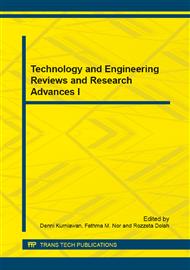[1]
Teng, J.G., Chen, J.F., and Lam, L. (2002), FRP-strengthened RC structures, John Wiley & Sons, Ltd., West Essex, England.
Google Scholar
[2]
FIB Bulletin 14 Technical Report (2001), Externally Bonded FRP Reinforcement for RC Structures, International Federation of Structural Concrete, Lausanne.
DOI: 10.35789/fib.bull.0014.ch01
Google Scholar
[3]
American Concrete Institute (ACI) (2002), Guide for the design and construction of externally bonded FRP systems for strengthening concrete structures, ACI-440, ACI-440 Committee, Detroit.
DOI: 10.14359/51700867
Google Scholar
[4]
Concrete Society (2012), Technical Report No. 55 – Design guidance for strengthening concrete structures using fibre composite materials, The Concrete Society, Surrey, United Kingdom.
Google Scholar
[5]
MS 544: 2001: Code of practice for structural use of timber, Department of Standards Malaysia, Shah Alam, Malaysia.
Google Scholar
[6]
Buchanan, A.H. (1990), Bending strength of lumber, ASCE Journal of Structural Engineering, Vol. 116, No. 5, 1990, pp.1213-1229.
DOI: 10.1061/(asce)0733-9445(1990)116:5(1213)
Google Scholar
[7]
André, A. and Kliger, R. (2009).
Google Scholar
[8]
Fiorelli, J. and Dias, A. A. (2003), Analysis of the strength and stiffness of timber beams reinforced with carbon fibre and glass fibre, Journal of Materials Research, Warrendale, PA, USA.
DOI: 10.1590/s1516-14392003000200014
Google Scholar
[9]
Yusof, A. (2013), Ductility of Timber Beams Strengthened Using Fiber Reinforced Polymer, Journal of Civil Engineering and Architure, USA, May 2013, Volume 7, No. 5 (Serial No. 66), pp.535-544.
DOI: 10.17265/1934-7359/2013.05.003
Google Scholar
[10]
Osmannezhad, S., Faezipour, M. and Ebrahimi, G. (2014), Effects of GFRP on bending strength of glulam made of poplar (Populus deltoids) and beech (Fagus orientalis), Construction and Building Materials 51 (2014), pp.34-39, Elsevier Ltd.
DOI: 10.1016/j.conbuildmat.2013.10.035
Google Scholar
[11]
Dagher, H., Gray, H., Davids, W., Silva-Henriquez, R. and Nader, J. (2010), Variable prestressing of FRP-reinforced glulam beams: methodology and behavior, World Conference on Timber Engineering (WCTE 2010), 20-24 June 2010, Trentino, Italy.
Google Scholar
[12]
Blaß, H. J., and Romani, M. (1998-2000), Reinforcement of glulam beams with FRP reinforcement. , University of Karlsruhe, Germany.
Google Scholar
[13]
Fiorelli, J. and Dias, A. A. (2011), Glulam beams reinforced with FRP externally-bonded: theoretical and experimental evaluation, Materials and Structures (2011) 44 pp.1431-1440.
DOI: 10.1617/s11527-011-9708-y
Google Scholar
[14]
National Research Council – Advisory Committee on Technical Recommendations for Construction (2007).
Google Scholar
[15]
Romani, M. and Blaß, H.J. (2001), Design model for FRP reinforced glulam beams, International Council for Research and Innovation in Building and Construction, CIB-W18, Venice, Italy.
Google Scholar
[16]
Khelifa, M. and Celzard, A. (2014), Numerical analysis of flexural strengthening of timber beams reinforced with CFRP strips, Composite Structures 111 (2014), pp.393-400, Elsevier Ltd.
DOI: 10.1016/j.compstruct.2014.01.011
Google Scholar
[17]
Guan, Z.W., Rodd, P.D. and Pope, D.J. (2005), Study of glulam beams pre-stressed with pultruded GRP, Computers & Structures 83 (2005) pp.2476-2487, Elsevier Ltd.
DOI: 10.1016/j.compstruc.2005.03.021
Google Scholar
[18]
Ogawa, H. (2000), Architectural application of carbon fibres, development of new carbon fibre reinforced glulam, Carbon, 38, 211-226.
Google Scholar
[19]
Lopez-Anido, R. and Xu, H. (2002), Structural characterization of hybrid fibre-reinforced polymer-glulam panels for bridge decks, Journal of Composites for Construction, 6(3), 194-203.
DOI: 10.1061/(asce)1090-0268(2002)6:3(194)
Google Scholar
[20]
Borri, A., Corradi, M. and Grazini, A. (2005), A method for flexural reinforcement of old wood beams with CFRP materials, Composites: Part B, 36, 143-153.
DOI: 10.1016/j.compositesb.2004.04.013
Google Scholar
[21]
Information on: http: /quakewrap. com/project_sheets/FRP%20Repair%20of%20Wooden%20Beams%20in%20High%20School%20Gymnasium. pdf (accessed on 1 July 2014).
Google Scholar
[22]
Gentile, C., Svecova, D. and Rizkalla, S. H. (2002), Timber beams strengthened with GFRP bars: development and applications, Journal of Composites for Construction, 6(1), 11-20.
DOI: 10.1061/(asce)1090-0268(2002)6:1(11)
Google Scholar
[23]
Kliger, R., Al-Emrani, M., Marie Johansson, M. and Crocetti, R. (2007), Strengthening Glulam Beams with Steel and Composite Plates, Proceedings of the Asia-Pacific Conference on FRP in Structures (APFIS 2007) Hong Kong, China, 291-296.
Google Scholar
[24]
Yusof, A. (2010), Bending behavior of timber beams strengthened using fiber reinforced polymer bars and plates, Ph.D. thesis, Faculty of Civil Engineering, Universiti Teknologi Malaysia, Johor, Malaysia.
DOI: 10.21833/ijaas.2017.03.001
Google Scholar
[25]
Buell, T. W. and Saadatmanesh, H. (2005), Strengthening Timber Bridge Beams Using Carbon Fiber, Journal of Structural Engineering. Vol 131, pp.1-199.
DOI: 10.1061/(asce)0733-9445(2005)131:1(173)
Google Scholar
[26]
Mokhtar, N.I. and Ahmad, Y. (2012), Reinforcing techniques using fiber-reinforced polymer: a review, APSEC-ICCER 2012, 2-4 October 2012, Surabaya, Indonesia.
Google Scholar
[27]
Kliger, R., André, A. and Haghani, R. (2013), Innovative Timber Composites: Improving wood with other materials, Composites 20+Polycon 09, 17th October 2013, Nicosia, Cyprus.
Google Scholar
[28]
André, A. (2006), Fibres for Strengthening of Timber Structures, PhD. Thesis, Division of Structural Engineering, Department of Civil and Environmental Engineering, Luleå, Sweden.
Google Scholar
[29]
Ranganathan, R. (2005), Structural reliability analysis and design, Jaico Publising House, Mumbai, India.
Google Scholar


